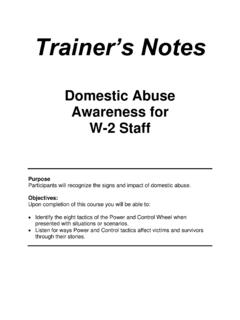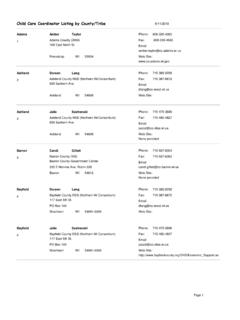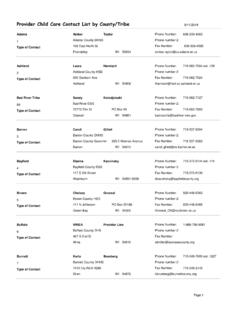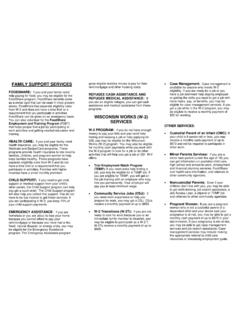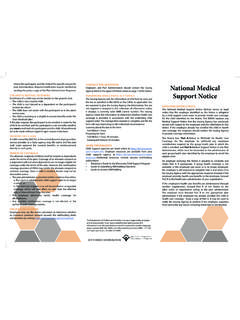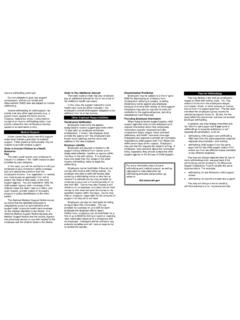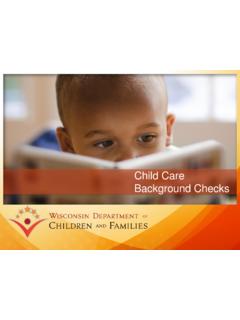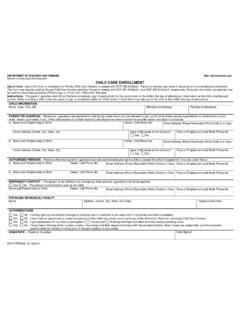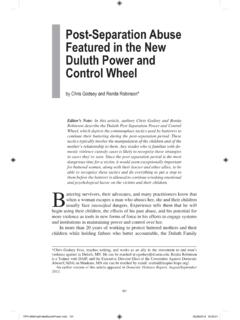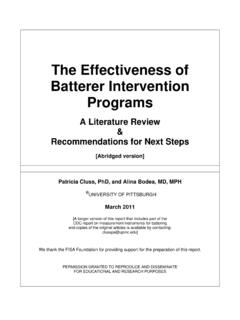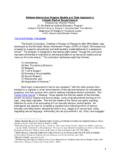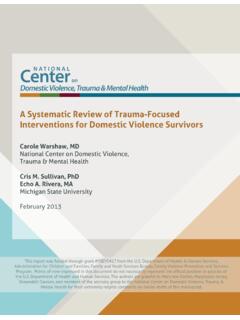Transcription of Domestic Violence Handbook - | Wisconsin Department of ...
1 Domestic Violence Handbook For Wisconsin child Protective services WorkersDepartment of Children and Families Division of Safety and Permanence 20103A note on language: because research shows that Domestic Violence is mostly committed by men against their female partners, this Handbook refers to abusers as he and victims as she . However, we recognize that men can also be victims of Domestic Violence and that Domestic Violence occurs in same-sex .. 6 Acknowledgements .. 7 Focus Groups with Battered 8 Guiding Principles .. 12 Background 14 What is Domestic Violence ?.. 14 Power and Control 15 Some Basic Facts About Domestic 16 Myths About Domestic 18 Impact of Domestic Violence on 20 Parenting by 23 Parenting by Battered 24 Practice Applications - 28 Table of Contents5 Practice Applications - Initial Assessment and 31 Practice 31 Interviewing Children about Domestic 33 Sample Questions for 34 Interviewing the Suspected Adult Victim of Domestic 36 Sample Questions for Adult 38 Interviewing the Alleged Perpetrator of Domestic 41 Sample Questions for the Adult 42 Disclosure of Domestic 44 Determining the Predominant 47 Substantiation Applications - Ongoing 50 Practice 50 Family the Bond Between the Child and their Most Protective 55 Accountability
2 For Abusive 58 Domestic Violence Safety 60 Identifying and Managing Safety 63 Working with Domestic Violence ProgramsHow Domestic Violence programs Can Support Mothers and Assist Child Protective 66 Laws Affecting Privacy and 70 ResourcesAdditional Wisconsin Laws on Domestic 72 Domestic abuse Restraining 74 Batterer Intervention 776 This Handbook was created by a group of Child Protective Services(CPS) and Domestic Violence (DV) professionals to provide useful information to CPS staff for cases in which Domestic Violence coexists with child maltreatment. This information is not intended to replace existing policies or practices, but to build on them. Additionally, the Handbook is not intended to replace, but complement and be coordinated with training for CPS workers and supervisors, from pre-service to specialized training.
3 How to Use This HandbookThe Handbook is not meant to be an encyclopedia on everything a CPS worker needs or wants to know about Domestic Violence , but rather a handy reference guide on some of the most important points to keep in mind when working with families. The Handbook provides information on situations where Domestic Violence is known, as well as those where CPS is assessing for the possible presence of Domestic Violence . CPS workers do not need to become experts in Domestic Violence . They can, however, gain information on issues related to Domestic Violence that provide a basis for good practice and for working collaboratively with DV counterparts. IntroductionThis Handbook can be used to: Raise general awareness on Domestic Violence ; Provide a basic foundation and resource guide when domesticviolence issues arise in practice; Identify topics for further training or for an in-service at a staff meeting;serve as a basis for a meeting and discussion with a local Domestic Violence counterpart.
4 7 AcknowledgementsThis project was nurtured and guided by a group of CPS supervisors and Domestic Violence advocates who met over the course of 18 months to share their wisdom, experience, and expertise. This project would not be what it is without their considerable efforts. The workgroup included:Cyrus Behroozi Task Force on Family Violence , Milwaukee, WI* Katie Schickowski Jefferson County Human Services DepartmentAnn Brickson Wisconsin Coalition Against Domestic Violence , Madison, WIUrsula Brunell Golden House, Green Bay, WICherie Griffin Women s Resource Center, Racine, WIWendy Gehl Harbor House Domestic abuse programs , Appleton WIKate Gravel Dane County Department of Human ServicesAmy Hendrick Outagamie Department of Healthy and Human ServicesMary Hennis Waukesha Women s Center, Waukesha, WIKaren Larson Domestic abuse Intervention Services, Madison, WI Sharon Lewandowski Department of Children and Families, Madison.
5 WISue Mueller Portage County Health and Human Services DepartmentJanis Ramos Waukesha County Department of Health and Human ServicesAmy Smith Department of Children and Families, Madison, WI*Michelle Winters La Crosse County Human Services Department *Affiliations are noted for the period of work on the HandbookThanks to Connie Klick, Section Manager, Child Welfare and Family Violence Section, Department of Children and Families, for her guidance, support, and expert editing throughout the The creation of this Handbook began with listening to the voices of battered women. As a kick-off to this project, the Wisconsin Coalition Against Domestic Violence conducted focus groups with 26 women who have been involved with the Child Protective Services due to alleged maltreatment of their own children.
6 All were victims of Domestic Violence , and volunteered to participate after being contacted by a local Domestic abuse agency. In most cases, the alleged maltreater was the participant s abusive partner. Focus groups were conducted from July, 2006 through June, 2007 at Domestic abuse programs in Wausau, Chippewa Falls, Lac du Flambeau, Milwaukee, Racine and Green group participants reported a wide variety of experiences with county child welfare and Indian Child Welfare agencies, both positive and negative. However, there were two reoccurring observations across all groups:1. Many women felt child protection workers failed to recognize their efforts to keep their children safe. 2. Many also felt that Child Protective Services failed to hold their abusive partners accountable for their actions.
7 * *It should be noted that while it is true that CPS is limited in its ability to sanction batterers, there are ways to think about abuser accountability that are discussed later in this women identified the following actions by Child Protective Services workers that they found helpful: Demonstrated an understanding of Domestic Violence . Tried to view her life from her perspective. Listened and offered support without judgment or blame. Encouraged her to take care of herself in order to better care for her children Provided the resources she needed to leave her abuser. Helped her continue to receive services from a Domestic Violence program. Helped her stay in touch with her children while they were in placement.
8 Focus Groups with Battered Women9 These women also identified the following actions by Child Protective Services staff as not helpful to their efforts to improve their situation or regain custody of their children: Didn t believe her safety concerns about her partner, including threats to the safety of her children. Didn t understand how Domestic Violence affected her efforts to protect her child. Lack of assistance regarding managing safety threats presented by her abusive partner. Blamed her for not leaving her partner. Pressured her to separate from her partner without providing practical support to help her leave. Failed to help her understand child welfare policies and procedures. Participants offered the following suggestions for child welfare staff who are working with battered mothers: Learn about Domestic Violence and how it affects mothers and children.
9 This was a frequent suggestion. Intervene with the father as well as the mother. Offer him services and expect him to change as well. This was another frequent comment. Take time to listen and understand what battered women have been through. Understand that for families affected by Domestic Violence , helping mothers stay safe also helps children be safe. Assist her to leave her violent relationship without blaming her for how difficult it is to do this. Ask about her safety and help provide protection from the abuser, such as not disclosing information that would facilitate stalking, offering an escort for court appearances, and using visitation and safe exchange Selected Comments by Focus Group Participants One woman described a relationship with a social worker that became a lifeline for her through some very difficult times.
10 She said that despite their differences (she is a poor African American woman and he is a middle class white man), he took the time to listen to her and tried to be in my shoes. He respected her choices while making sure that her kids were safe. Another woman said that her social worker looked beyond the abuse of her children to recognize and understand Domestic Violence . The social worker provided the resources this woman needed to leave her abusive partner, something she would have been unable to do on her own. I would want them (CPS workers) to have mandatory training in Domestic Violence issues. To understand the kinds of things abusers almost always do. Manipulate the system, to keep their control. I keep hearing over and over again that victims are called on the carpet.
